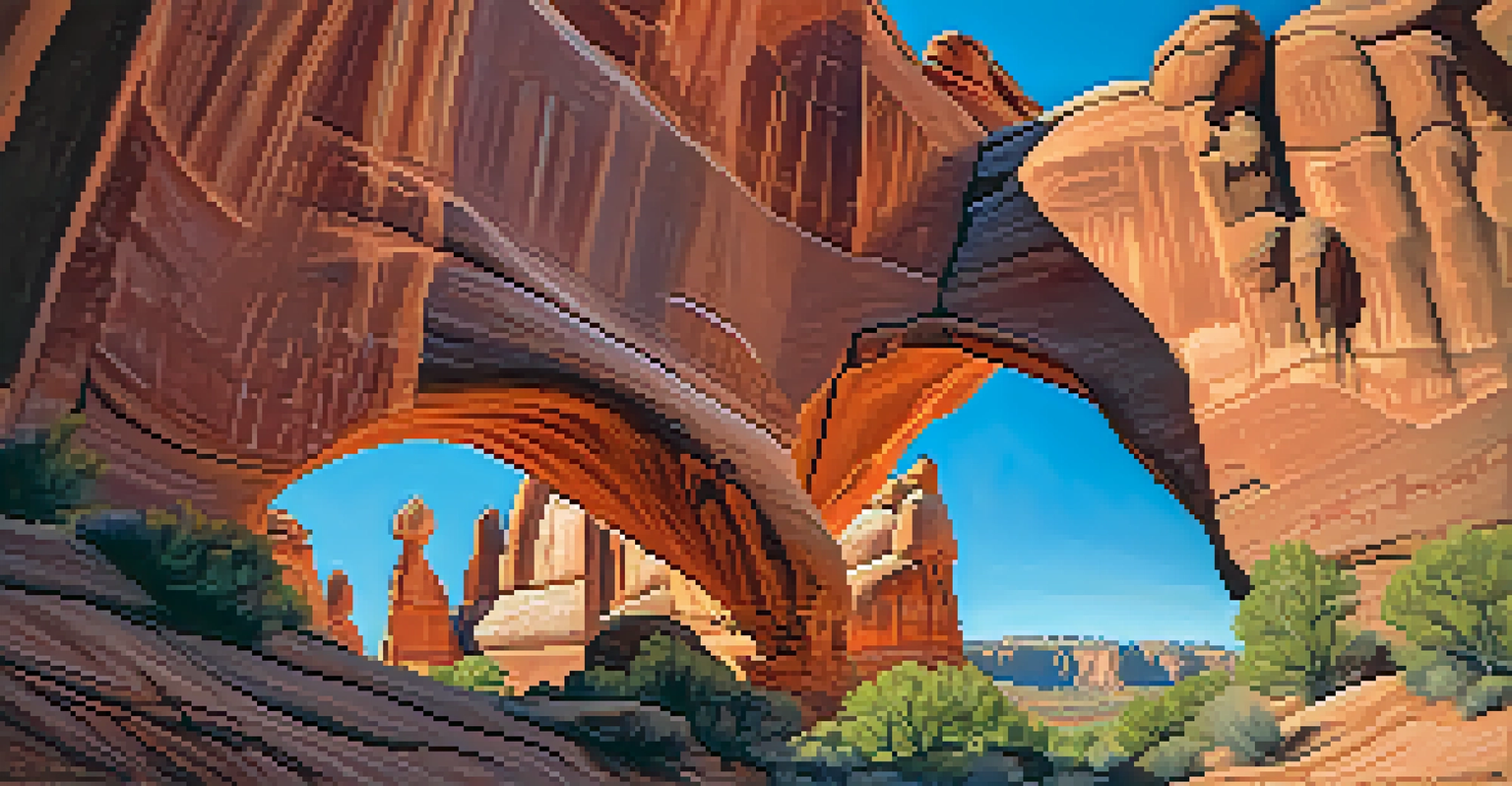Geological History of Utah: Mountains and Canyons Unveiled

Understanding the Formation of Utah's Mountains
Utah's mountains are not just picturesque; they tell a story of geological evolution. The Wasatch Range, for instance, formed due to tectonic uplift, where the Earth's crust buckled and folded. This dramatic process has created towering peaks that dominate the skyline, like Mount Timpanogos, which stands at over 11,000 feet.
The earth has music for those who listen.
Through millions of years of erosion, these mountains have been sculpted into their current forms. Rivers and glaciers have worked tirelessly to carve out valleys, leaving behind spectacular vistas that are both breathtaking and educational. Each layer of rock reveals a chapter of Utah's geological tale.
Moreover, these mountains also serve as a habitat for diverse flora and fauna. The interplay of altitude and climate creates unique ecosystems, making the Wasatch Range not only a geologist's dream but also a haven for hikers and nature lovers alike.
The Role of Erosion in Shaping Utah's Canyons
Erosion is a powerful force that has significantly shaped Utah's canyons, turning the landscape into a stunning tapestry of rock formations. The mighty Colorado River, for example, has carved out the Grand Canyon over millions of years, showcasing layers of sediment that reveal ancient environments. This process emphasizes the dynamic nature of the Earth’s surface.

Canyons like Zion and Bryce are prime examples of erosion at work. Water, wind, and ice have all played a role in sculpting their dramatic cliffs and narrow passages. The vibrant colors and unique rock formations tell a story of resilience and transformation throughout geological time.
Geological Evolution of Utah's Landscape
Utah's mountains, canyons, and volcanic sites reflect a rich geological history shaped by processes like erosion, tectonic uplift, and volcanic activity.
Additionally, these canyons serve as natural laboratories for studying Earth's history. Each layer of rock within the canyon walls provides clues about past climates, flora, and fauna, allowing scientists to piece together the puzzle of our planet's evolution.
The Impact of Volcanic Activity on Utah's Landscape
While Utah is often associated with its majestic mountains and canyons, volcanic activity has also played a crucial role in shaping its landscape. The state's volcanic history is evident in places like the West Desert and the Uinta Mountains, where ancient lava flows can be found. These remnants of volcanic eruptions add a unique aspect to Utah’s geological narrative.
Nature does not hurry, yet everything is accomplished.
The most famous volcanic site is the San Rafael Swell, where volcanic rock formations stand as a testament to the Earth's fiery past. These formations serve not only as geological wonders but also as sites for recreational activities such as hiking and photography, attracting visitors year-round.
Volcanic soil also enriches the land, providing nutrients that support diverse ecosystems. This interplay between volcanic activity and the environment highlights the complexity of Utah's geology and its ongoing influence on life in the region.
Sedimentary Layers: A Record of Time in Utah
Sedimentary rock layers in Utah provide a fascinating window into the geological past, revealing how the region has transformed over millions of years. Each layer represents a different time period, capturing ancient environments—from vast oceans to arid deserts. This history is crucial for understanding the planet's evolution.
The famous formations of Arches National Park, for instance, are primarily composed of sandstone that has been shaped by both erosion and sedimentation. These formations, with their intricate arches and spires, showcase the beauty that can emerge from geological processes over time.
Unique Ecosystems and Biodiversity
The diverse geological features in Utah support a variety of ecosystems, from the Great Salt Lake's saline habitat to the unique flora and fauna of the Wasatch Range.
Moreover, these sedimentary layers are not just visually stunning; they are also rich in fossils. Fossils found within these strata provide insights into the types of creatures that once roamed the area, allowing us to piece together a more complete picture of Utah's ancient ecosystems.
The Great Salt Lake: A Geological Marvel
The Great Salt Lake, one of Utah's most iconic features, is a remnant of the ancient Lake Bonneville, which once covered much of the region. This massive lake has a unique geological history, characterized by high salinity levels that create a distinct ecosystem. The lake's fluctuating water levels over time have left behind fascinating salt flats and mineral deposits.
This unique environment supports a variety of wildlife, particularly migratory birds that rely on the lake as a crucial stopover. The Great Salt Lake's ecosystem highlights the intricate connections between geology and biology, showcasing how geological features can shape habitats.
In addition, the lake plays a vital role in Utah's economy, supporting industries such as salt mining and tourism. Its surreal landscapes, combined with the natural beauty surrounding it, make the Great Salt Lake a must-visit destination, allowing visitors to appreciate the interplay of geology and nature.
The Influence of Climate on Utah's Geology
Climate has a profound impact on Utah's geological features, shaping the landscape in ways that are both subtle and dramatic. The arid conditions in many parts of the state contribute to the rapid erosion of rocks, leading to the formation of unique landforms such as hoodoos and cliffs. This dynamic relationship between climate and geology is fascinating to observe.
Seasonal changes, particularly the winter snowmelt, also play a significant role in sculpting Utah's canyons and valleys. As water flows through these areas, it carves out new paths and alters existing features, demonstrating the power of natural forces at work.
Cultural Significance of Natural Landmarks
Utah's geological formations not only inspire scientific exploration but also hold deep cultural importance for Indigenous communities and artists alike.
Furthermore, climate change poses challenges for Utah's geological stability. Increased temperatures and changing precipitation patterns can lead to increased erosion and landslides, highlighting the need for ongoing research and conservation efforts to protect these stunning landscapes.
Cultural Significance of Utah's Geological Features
Utah's unique geological features not only captivate scientists but also hold cultural significance for many communities. Indigenous tribes have long recognized the spiritual and practical importance of the land, often using its resources sustainably. These connections illustrate the deep-rooted relationship between people and the geological landscape.
Landmarks like Monument Valley and the Delicate Arch have become symbols of both natural beauty and cultural heritage. They attract visitors from around the world, eager to explore these iconic sites and learn about the stories behind them. This blend of geology and culture enriches the visitor experience.

Moreover, Utah's geology has inspired artists, writers, and filmmakers, contributing to a rich tapestry of cultural expression. The stunning vistas and unique formations serve as a backdrop for creativity, allowing individuals to connect with the land in meaningful ways and celebrate its beauty.